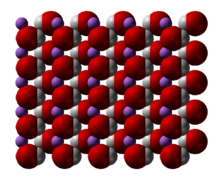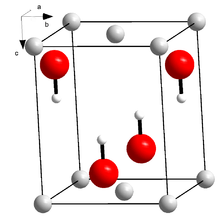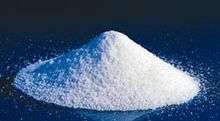Lithium hydroxide
Lithium hydroxide is an inorganic compound with the formula LiOH. It is a white hygroscopic crystalline material. It is soluble in water and slightly soluble in ethanol, and is available commercially in anhydrous form and as the monohydrate (LiOH.H2O). While lithium hydroxide is a strong base, it is the weakest known alkali metal hydroxide.
 | |
 | |
 | |
| Names | |
|---|---|
| IUPAC name
Lithium hydroxide | |
| Identifiers | |
3D model (JSmol) |
|
| ChEBI | |
| ChemSpider | |
| ECHA InfoCard | 100.013.804 |
| 68415 | |
PubChem CID |
|
| RTECS number |
|
| UNII | |
| UN number | 2680 |
CompTox Dashboard (EPA) |
|
| |
| |
| Properties | |
| LiOH | |
| Molar mass |
|
| Appearance |
|
| Odor | none |
| Density |
|
| Melting point | 462 °C (864 °F; 735 K) |
| Boiling point | 924 °C (1,695 °F; 1,197 K) decomposes |
| |
| Solubility in methanol |
|
| Solubility in ethanol |
|
| Solubility in isopropanol |
|
| Basicity (pKb) | −0.04[3] |
| Conjugate base | Lithium monoxide anion |
| −12.3·10−6 cm3/mol | |
Refractive index (nD) |
|
| Thermochemistry | |
Heat capacity (C) |
2.071 J/g⋅K |
Std enthalpy of formation (ΔfH⦵298) |
−20.36 kJ/g |
| Hazards | |
| Main hazards | Corrosive |
| Safety data sheet | "ICSC 0913". "ICSC 0914". (monohydrate) |
| NFPA 704 (fire diamond) | |
| Flash point | Non-flammable |
| Lethal dose or concentration (LD, LC): | |
LD50 (median dose) |
210 mg/kg (oral, rat)[4] |
| Related compounds | |
Other anions |
Lithium amide |
Other cations |
Sodium hydroxide Potassium hydroxide Rubidium hydroxide Caesium hydroxide |
Related compounds |
Lithium oxide |
Except where otherwise noted, data are given for materials in their standard state (at 25 °C [77 °F], 100 kPa). | |
| Infobox references | |
Production and reactions
Lithium hydroxide is produced in a metathesis reaction between lithium carbonate and calcium hydroxide:[5]
- Li2CO3 + Ca(OH)2 → 2 LiOH + CaCO3
The initially produced hydrate is dehydrated by heating under vacuum up to 180 °C.
In the laboratory, lithium hydroxide arises by the action of water on lithium or lithium oxide. The equations for these processes follow:
- 2 Li + 2 H2O → 2 LiOH + H2
- Li2O + H2O → 2 LiOH
Typically, these reactions are avoided.
Although lithium carbonate is more widely used, the hydroxide is an effective precursor to lithium salts, e.g.
- LiOH + HF → LiF + H2O.
Gas phase chemistry
The acidity of LiOH has been measured in the gas phase. The oxidolithium anion, LiO–, was produced by successive decarboxylation and decarbonylation of monolithium oxalate anion, LiO(C=O)(C=O)O–, by collision-induced dissociation and was identified by its exact mass. The gas-phase acidity of LiOH was inferred from the experimentally determined electron affinity of LiO• and previously known heats of formation to give a value of 426 ± 2 kcal/mol. This is considerably higher than the gas-phase acidity of water (390 kcal/mol) and even exceeds that of methane (417 kcal/mol). Thus, LiOH is a very weak acid and is in fact the weakest acid yet measured in the gas phase.[6]
Applications
Lithium hydroxide is mainly consumed in the production of lithium greases. A popular lithium grease thickener is Lithium 12-hydroxystearate, which produces a general-purpose lubricating grease due to its high resistance to water and usefulness at a range of temperatures.
Carbon dioxide scrubbing
Lithium hydroxide is used in breathing gas purification systems for spacecraft, submarines, and rebreathers to remove carbon dioxide from exhaled gas by producing lithium carbonate and water:[7]
- 2 LiOH•H2O + CO2 → Li2CO3 + 3 H2O
or
- 2 LiOH + CO2 → Li2CO3 + H2O
The latter, anhydrous hydroxide, is preferred for its lower mass and lesser water production for respirator systems in spacecraft. One gram of anhydrous lithium hydroxide can remove 450 cm3 of carbon dioxide gas. The monohydrate loses its water at 100–110 °C.
Other uses
It is used as a heat transfer medium and as a storage-battery electrolyte. It is also used in ceramics and some Portland cement formulations. Lithium hydroxide (isotopically enriched in lithium-7) is used to alkalize the reactor coolant in pressurized water reactors for corrosion control.[8]
Market
In 2012, the price of lithium hydroxide was about $5,000 to $6,000 per tonne.[9]
See also
References
- Lide, David R., ed. (2006). CRC Handbook of Chemistry and Physics (87th ed.). Boca Raton, FL: CRC Press. ISBN 0-8493-0487-3.
- Khosravi J (2007). Production of Lithium Peroxide and Lithium Oxide in an Alcohol Medium. Chapter 9: Results. ISBN 978-0-494-38597-5.
- Popov K, Lajunen LH, Popov A, Rönkkömäki H, Hannu-Kuure H, Vendilo A (2002). "7Li, 23Na, 39K and 133Cs NMR comparative equilibrium study of alkali metal cation hydroxide complexes in aqueous solutions. First numerical value for CsOH formation". Inorganic Chemistry Communications. 5 (3): 223–225. Retrieved 21 January 2017.
- Chambers M. "ChemIDplus – 1310-65-2 – WMFOQBRAJBCJND-UHFFFAOYSA-M – Lithium hydroxide anhydrous – Similar structures search, synonyms, formulas, resource links, and other chemical information". chem.sis.nlm.nih.gov. Retrieved 12 April 2018.
- Wietelmann U, Bauer RJ (2000). "Lithium and Lithium Compounds". Ullmann's Encyclopedia of Industrial Chemistry. doi:10.1002/14356007.a15_393. ISBN 3-527-30673-0.
- Tian Z, Chan B, Sullivan MB, Radom L, Kass SR (June 2008). "Lithium monoxide anion: a ground-state triplet with the strongest base to date". Proceedings of the National Academy of Sciences of the United States of America. 105 (22): 7647–51. doi:10.1073/pnas.0801393105. PMC 2409378. PMID 18511563.
- Jaunsen JR (1989). "The Behavior and Capabilities of Lithium Hydroxide Carbon Dioxide Scrubbers in a Deep Sea Environment". US Naval Academy Technical Report. USNA-TSPR-157. Archived from the original on 2009-08-24. Retrieved 2008-06-17.
- Managing Critical Isotopes: Stewardship of Lithium-7 Is Needed to Ensure a Stable Supply, GAO-13-716 // U.S. Government Accountability Office, 19 September 2013; pdf
- "Lithium Prices 2012". investingnews.com. Investing News Network. Retrieved 12 April 2018.
External links
| Wikimedia Commons has media related to Lithium hydroxide. |
- International Chemical Safety Card 0913 (anhydrous)
- International Chemical Safety Card 0914 (monohydrate)
